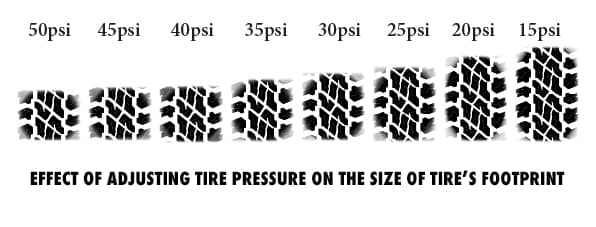قيادة سيارة دفع رباعي على الرمال تتطلب فهم مبدأين بسيطين، هما: ضغط الإطارات وقوة الدفع، بالإضافة إلى تطوير بعض تقنيات القيادة. سنتناول شرح قوة الدفع في مقال آخر وسنتكلم عن ضغط الهواء في الإطارات هنا.
في الرمال العميقة، العنصر الأساسي الذي يعد عاملًا حاسمًا للمحافظة على التحرك إلى الأمام هو ضغط الإطارات. افهم جيدًا الكيفية التي يعمل بها ضغط الإطارات على الرمال وسيؤدي ذلك إلى تحسين فرص نجاحك والابتعاد كثيرًا عن المشاكل والقيادة بدون متاعب.
 
القصور الذاتي
بشكل أساسي، يواجه معظم السيارات صعوبة عند السير على الرمال المتحركة بسبب القصور الذاتي. القصور الذاتي هو قابليّة الأجسام المتحركة للاستمرار بالحركة وقابليّة الأجسام الساكنة للبقاء ساكنة. وبمعنى آخر هو "مقاومة الجسم المتحرك للسكون، ومقاومة الجسم الساكن للحركة". تندفع الرمال بعيدًا عن الإطار الدوّار لأنه من السهل للإطار أنه يقوم بتحريك الرمال بعيدًا بدلًا من تحريك السيارة للأمام. ونأمل أن تصبح أربعة إطارات دوّارة كافية لتأرجح الميزان في صالحنا وتوليد القدر الكافي من قوة الدفع حتى نبدأ في الانطلاق للأمام. يمكننا بسهولة ترجيح كفة الميزان لصالحنا من خلال القيام بإجراء بسيط وهو أن ندع قليلًا من الهواء يخرج وبالتالي يتغير ضغط الهواء بداخل الإطارات. انظر إلى هذا الرسم التخطيطي البسيط وستبدأ في فهم كيفية القيام بذلك والسبب وراء ذلك.
من خلال خفض ارتفاع العجلة بنسبة 25٪ (عن طريق التفريغ من الهواء)، يمكننا زيادة تأثير مداس الإطارات على الأرض بنسبة تصل إلى 200٪. وبالتالي تُصبح إطارات سيارتنا مشابهة للجنازير الموجودة في الجرافة. ينتهي بنا الأمر بالحصول على زيادة هائلة في التلامس والاتصال السطحي مما يعني أنه يصبح من السهل على الإطار الدوّار دفع السيارة للتحرك للأمام بدلًا من دفع الرمال بعيدًا.
كيفية تحديد ضغط الإطارات الصحيح للسير على الرمال
بافتراض أن الإطارات الخاصة بك عند مستوى الضغط الصحيح المناسب للقيادة في الشوارع والطرقات، فمن هنا، يمكننا تقريبًا تحديد مستوى الضغط الصحيح للإطارات المناسب للسير على الرمال بهذه الطريقة.
اركن سيارتك ذات الدفع الرباعي على سطح مستوٍ صلب وقِس المسافة بين الحافة السفلية من الإطار والطريق (أ)
قم بتقليص ضغط الإطار حتى تصبح هذه المسافة 75٪ من الارتفاع الأصلي (ب)
على سبيل المثال، إذا كانت المسافة في المثال (أ) هي 100 مم، فإن المسافة في المثال (ب) تصبح 75 مم.
المثال (أ) يشير إلى ضغط الإطارات الخاصة بك المناسبة للسير في الشارع و(ب) هو ضغط الإطارات الخاصة بك المناسبة للسير في الرمال.
قِس هذا الضغط وسجله عندك واستخدمه كنقطة انطلاق في المرة القادمة التي تقود فيها سيارتك على الرمال. ليست هناك بيئتان متشابهتان من بيئات القيادة ولا مركبتان متماثلتان. يؤدي العديد من العوامل مثل نوع الرمال ووزن السيارة والإطار على وجه التحديد دورًا في تحديد الضغط الصحيح للإطارات ولا يمكن لأي عامل منفرد أن ينجح في كل حالة.
يطبق العديد من الأشخاص قاعدة الروتين القائم على التَّجربة العَمَليَّة ويقللون ضغط إطاراتهم إلى ما بين 18 إلى 22 رطلًا لكل بوصة مربعة كنقطة انطلاق للقيادة على الرمال. (إذا كنت تقيس بالبار (Bar) كوحدة قياس مترية بدلًا من الرطل لكل بوصة مربعة (Psi)، يمكنك البحث على محول في هذه الحالة)
يؤدي كل من محتوى الرطوبة ودرجة حرارة الرمال والضغط دورًا في السحب والجر، وإذا لم يتسبب هذا التقليل في ضغط الهواء - الذي قمت به في بادئ الأمر - إلى الاندفاع والتحرك للأمام، فقلّل الضغط مرة أخرى حتى تقود سيارتك على نحو مريح. قلل ضغط الإطارات بمقدار 3 أو 4 أرطال لكل بوصة مربعة في المرة الواحدة. من الممكن تقليل ضغط الإطارات إلى أقل من 10 أرطال لكل بوصة مربعة دون التعرض لخطر تلف الإطارات. على الرغم من أنه لا يُنصح بذلك عند القيادة لمسافات طويلة، إلا أنه من الأفضل والأكثر أمانًا بشكل عام الخروج من الرمال الناعمة بهذه الطريقة بدلًا من الاضطرار إلى سحب السيارة بعد أن تعلق في الرمال.
عند التسارع والضغط على المكابح والانعطاف بإطارات ذات ضغط منخفض، توخّ المزيد من الحذر وقُد سياراتك بهدوء. فالإفراط في الحماس عند القيادة تجعل من الممكن دحرجة الإطارات خارج العجلات عندما تكون الإطارات ذات ضغط منخفض.
وبالمثل، يجب تجنب القيادة بسرعات عالية وقيادة السيارة على البيتومين إن أمكن. إذا كنت مضطرًا للقيادة على البيتومين بإطارات ذات ضغط منخفض للهواء، فتوخّ الحذر الشديد عند تغيير السرعة والاتجاه.
المعدات
على الرغم من أنه يمكنك القيام بذلك بدون أي معدات أو الاضطرار للذهاب إلى أي محطة خدمة لإعادة نفخ الإطارات فيما بعد، فإن امتلاكك لمقياس ضغط الهواء في الإطارات وضاغط هواء يجعل الأمر أكثر سهولة.
فإذا كنت تنوي القيام بالكثير من الأعمال بالسيارة في البيئات الرملية، فربما ينتهي بك الأمر بامتلاك ضاغط. على الرغم من أن نفخ الإطارات عن طريق ولاعة السجائر بالسيارة سيؤدي المهمة، إلا أنه سيكون بطيئًا وفي كثير من الأحيان وسيجب عليك التخلي عن الأمر في أكثر الأوقات إزعاجًا. ومع ذلك، فإن أجهزة قياس الإطارات الجيدة رخيصة نسبيًا ومن المحتمل أن تدوم وحدة القياس عالية الجودة طويلًا.
يمكن أن تمثل القيادة على الرمال متعة كبيرة بالنسبة لك ويمكن أن تجعلك تصل إلى أماكن لن تزورها على الأرجح. تعد عملية تقليل ضغط الإطارات الطريقة الأكثر فاعلية للحفاظ على الانطلاق للأمام بالسيارة في الطرق الموحلة والمستنقعات.
Â

